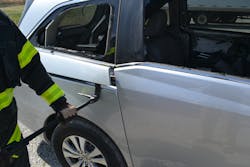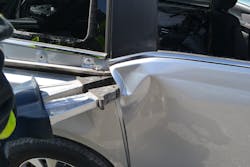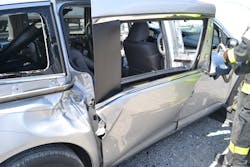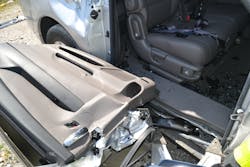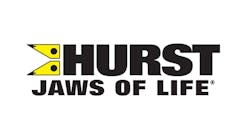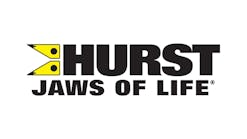University of Extrication: Forcing Open Minivan Sliding Doors
Topic: Jammed sliding side door technique update
Objective: The rescue team shall ensure that its forcible entry protocol to open a jammed minivan sliding door is up to date
Task: The rescue team shall update procedures as necessary and practice forcing open and removing manual and power sliding doors on minivans
Although minivans aren’t the most popular automobiles in today’s market, a large number of them are on the road. Innovations that were incorporated into vehicles over the past few model years can influence the jammed sliding door forcible opening task.
Outward first
Rescuers should be practiced in step-by-step procedures and should have almost a mental checklist to ensure that their efforts are quick and efficient when they must force open and remove a jammed sliding door on any vintage minivan.
One of the most significant facts to be aware of is that when a sliding door functions normally, its first movement is to pop outward. This outward-first action is what rescuers should mimic when the door is found jammed because of a collision.
Dual door latches should be anticipated. A latch at the front of the sliding door secures to the B-pillar. A similar latch or alignment pin can be found on the rear edge of the same door. If it is an actual latch, it secures the closed door to the body of the vehicle at the C-pillar.
Once it’s open, the door’s rearward sliding movement utilizes multiple arms that have small rollers to allow the door to glide rearward along a series of two or three tracks. Usually, one track follows along the roofline area. A second track most likely will be found at a midpoint along the exterior of the body. If present, a third glide track will be at or below floor level.
When all of these tracks are in alignment with each other, the door will move or slide rearward. If a collision caused one or more of the tracks to deform/be out of alignment, the door will jam and won’t move rearward beyond a certain point.
A power sliding door incorporates a motor that’s attached with a wire cable to open and close the door. Like a manually operated door, it can’t open the door when the tracks are out of alignment.Windows
Window safety glass in a minivan sliding door can be a fixed full-frame glass panel, a hinged swing-out pane or of a design that permits the glass to be partially lowered inside of the door. The side door safety glass can be tempered, although laminated safety glass might be found.
Make sure that your protocol includes dealing with partially open windows inside of a jammed door as well as knowing how to work with laminated glass.
Stabilization, power shutdown
A rescue agency’s procedure for forcing open and removing a jammed sliding door should include ensuring vehicle stabilization, gaining patient access to all rows of seats and 12-volt power shutdown. Occupant-carrying load in a typical minivan should be anticipated at as many as six persons, with certain configurations allowing as many as eight seated and belted occupants.
With the advent of hybrid and electric minivans, inside rescue personnel must place the vehicle in Park and turn off the ignition as part of their duties. With the ignition of an electric or hybrid minivan turned off, the flow of high voltage from the vehicle’s high-voltage battery is stopped and the internal combustion engine, if present, is shut off. However, turning off the ignition doesn’t shut down any low-voltage/12-volt power. Make sure that your protocol includes the University of Extrication’s seven-step Lock Out/Tag Out procedure for hybrid and electric vehicles.
Remember, if your minivan stabilization efforts involve tire deflation, modern minivan tires could include tire-pressure monitoring systems, or they can be run-flat models, which present additional deflation challenges. Make sure that you/your crew also are able to deal with possible tire challenges that can present themselves on high-ground-clearance vehicles.
Push the button
Consider using the vehicle’s 12-volt power to unlock and operate a functional power sliding door prior to powering down the vehicle. Power sliding door controls might be on the instrument panel, high on a ceiling-mounted console or on the door itself.
If the crash destroyed the 12-volt battery or if first-due responders already double-cut the battery cables, you are left without vehicle 12-volt power. Although nothing will happen when you push a power door button when there is no 12-volt power, a power sliding door on a minivan still will open manually using either the outside or inside door handles.
Try before you pry
After a vehicle is stabilized, power is shut down, and all of the patients are accessed and protected, work can begin on the door. Try before you pry here. Check to see whether the door is unlocked; when it is, try both the inside and the outside handles at the same time, if possible, in an attempt to manually open the sliding door.
If the door is confirmed as physically jammed, opening efforts must mimic the door’s initial outward action. To do this, it’s recommended that you attack the rear edge of the door first. If you need to create a purchase point, an outside rescuer might be able to remove a trim piece along the exterior body panel just to the rear of the sliding door. If no small panel exists, squeezing the door edge with a spreader or prying with a Halligan can produce the purchase point that’s needed.
When prying the door with a spreading tool, remember to work the tool so that the force is a down-and-out action. Hold the inside spreader arm a little higher than the outside arm. It’s less efficient to spread or force the minivan door straight forward, because this can jam it further at the B-pillar and front latch assembly. A down-and-out prying effort gets the door to come away from the body of the vehicle, which is what you want.
If the door will lie down like a wing, almost horizontal, it might pop off of the vehicle as the hinges and rollers release. If it does lie down but doesn’t want to move rearward, out of your way, apply a spreading tool from the B-pillar to force it rearward. If the door at least pops out from the vehicle but won’t lie down, use your spreader to get inside of the door to pry it outward until either the hinges and rollers fail or you have enough space to cut off the door at the hinges.
If you encounter a power sliding door, an umbilical cord/power cable will be attached from the vehicle to the door. Since power was shut down prior to starting this task, it’s safe to cut this cable and move the door to the debris area.
Ron Moore will present “Vehicle Rescue 2021 Update” and “Electric and Autonomous Vehicles” at Firehouse Expo. To register, visit firehouseexpo.com.
Jammed Sliding Minivan Door Update
· Vehicle stabilization
· Patient access (x8)
· Vehicle in Park
· Door unlocked & power opening?
· Door window lowering?
· Turn ignition off
· 12-volt power shutdown
· Manual opening attempt?
· Interior protection and window glass removal
· Door set-up and forcing at rear latch
· Door forcing at front latch
· Door laydown
· Door rearward movement
· Door removal to debris area

Ron Moore
RON MOORE, who is a Firehouse contributing editor, recently retired as a division chief with the McKinney, TX, Fire Department and now serves with Prosper, TX, Fire Rescue. He self-published the Vehicle Rescue 1-2-3 training manual and serves as the forum moderator for the extrication section of Firehouse.com . Moore can be contacted directly at [email protected].
